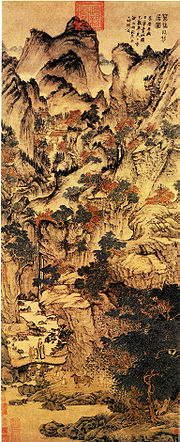
Wang Meng (artist)
Encyclopedia

Chinese painting
Chinese painting is one of the oldest continuous artistic traditions in the world. The earliest paintings were not representational but ornamental; they consisted of patterns or designs rather than pictures. Early pottery was painted with spirals, zigzags, dots, or animals...
painter
Painting
Painting is the practice of applying paint, pigment, color or other medium to a surface . The application of the medium is commonly applied to the base with a brush but other objects can be used. In art, the term painting describes both the act and the result of the action. However, painting is...
during the Yuan Dynasty
Yuan Dynasty
The Yuan Dynasty , or Great Yuan Empire was a ruling dynasty founded by the Mongol leader Kublai Khan, who ruled most of present-day China, all of modern Mongolia and its surrounding areas, lasting officially from 1271 to 1368. It is considered both as a division of the Mongol Empire and as an...
. He was born in Huzhou (湖州), now known as Wuxing (吴兴), Zhejiang
Zhejiang
Zhejiang is an eastern coastal province of the People's Republic of China. The word Zhejiang was the old name of the Qiantang River, which passes through Hangzhou, the provincial capital...
.
Wang Meng is considered to be one of the four great masters of the Yuan Dynasty
Yuan Dynasty
The Yuan Dynasty , or Great Yuan Empire was a ruling dynasty founded by the Mongol leader Kublai Khan, who ruled most of present-day China, all of modern Mongolia and its surrounding areas, lasting officially from 1271 to 1368. It is considered both as a division of the Mongol Empire and as an...
, along with Huang Gongwang
Huang Gongwang
Huáng Gōngwàng was a painter born during the late Song Dynasty in Changshu, Jiangsu. He is the oldest of the "four great masters of the Yuan." After serving as an official he acted as a Taoist priest. He spent his last years in the Fu-ch'un mountains near Hangzhou devoting himself to Taoism. It...
, Wu Zhen
Wu Zhen
Wu Zhen was a painter during the Yuan dynasty of China. He followed the Dong Yuan school of painting. Following along with trends of the time, Wu's works tended less toward naturalism and more toward abstraction, focusing on dynamic balance of elements, and personifying nature...
, and Ni Zan
Ni Zan
Ni Zan was a Chinese painter during the Yuan Dynasty. Along with Huang Gongwang, Wu Zhen, and Wang Meng, he is considered to be one of the four "Late Yuan" masters....
. They famously refused to serve the Mongolian rulers of their country. In contrast to many renowned painters in past history, these artists mostly worked on paper instead of silk, an indication of the importance they gave to the calligraphic
Calligraphy
Calligraphy is a type of visual art. It is often called the art of fancy lettering . A contemporary definition of calligraphic practice is "the art of giving form to signs in an expressive, harmonious and skillful manner"...
touch of the brush on paper. They exclusively painted landscapes, which they believed to be the visible key to the invisible reality. They restricted their acquaintenceship to each other, and like-minded "wen ren" (gentleman-scholars).
Wang Meng was the youngest of the group, and the least famous in his own time. Nevertheless, his style greatly influenced later Chinese Painting. In contrast to the relatively spare style of his compatriots, his ropy brushstrokes piled one on the other to produce masses of texture combined in dense and involved patterns.
Many artists copied the works of Wáng Méng centuries after his death, most notably Dong Qichang
Dong Qichang
Dong Qichang , courtesy name Xuanzai , was a Chinese painter, scholar, calligrapher, and art theorist of the later period of the Ming Dynasty.-Painter:...
.
His most famous works are the Ge Zhichuan Relocating, Forest Grotto at Juqu, Writing Books under the Pine Trees, The Simple Retreat, and Dwelling in the Qingbian Mountains. Most of his masterpieces are now located in notable museums around the world, such as the Palace Museum, National Palace Museum
National Palace Museum
The National Palace Museum is an art museum in Taipei. It is the national museum of the Republic of China, and has a permanent collection of over 677,687 pieces of ancient Chinese artifacts and artworks, making it one of the largest in the world. The collection encompasses over 8,000 years of...
, Shanghai Museum
Shanghai Museum
The Shanghai Museum is a museum of ancient Chinese art, situated on the People's Square in the Huangpu District of Shanghai, People's Republic of China.-History:...
, Cleveland Museum of Art
Cleveland Museum of Art
The Cleveland Museum of Art is an art museum situated in the Wade Park District, in the University Circle neighborhood on Cleveland's east side. Internationally renowned for its substantial holdings of Asian and Egyptian art, the museum houses a diverse permanent collection of more than 43,000...
and the Metropolitan Museum of Art
Metropolitan Museum of Art
The Metropolitan Museum of Art is a renowned art museum in New York City. Its permanent collection contains more than two million works, divided into nineteen curatorial departments. The main building, located on the eastern edge of Central Park along Manhattan's Museum Mile, is one of the...
. In 2011, a lesser known work of his from a private collection, titled Zhichuan Resettlement, was sold for 402.5 million yuan (US$62.1 million) at art auction.
External links
- Wang Meng and his painting gallery at China Online Museum

